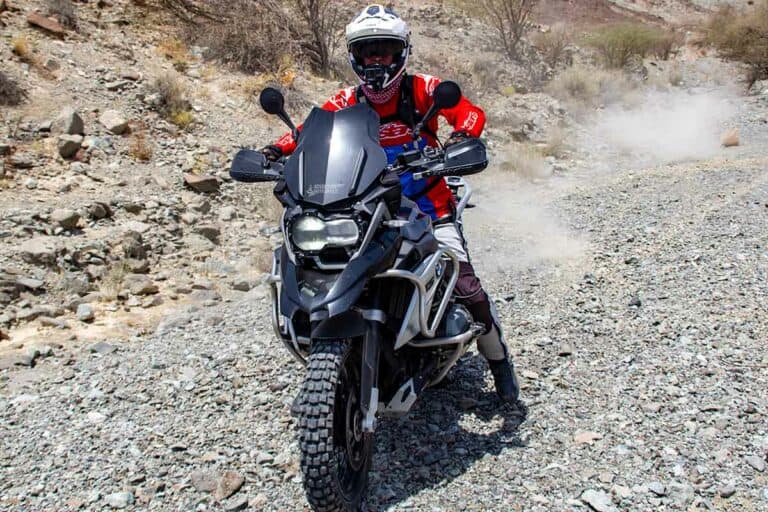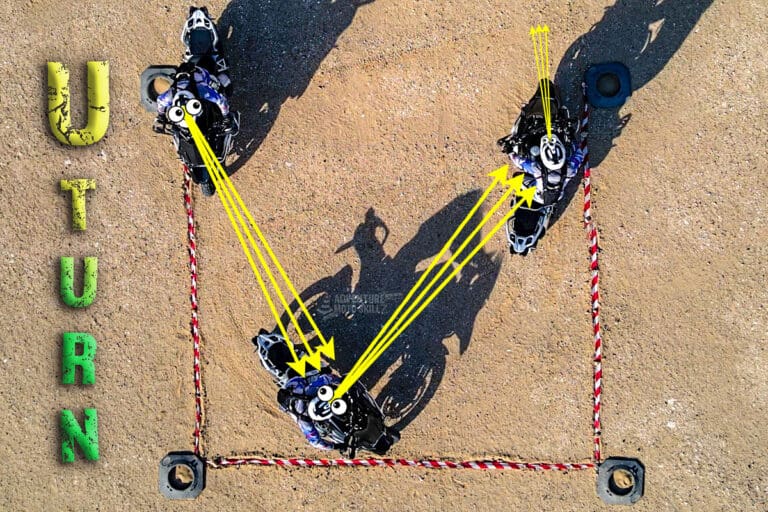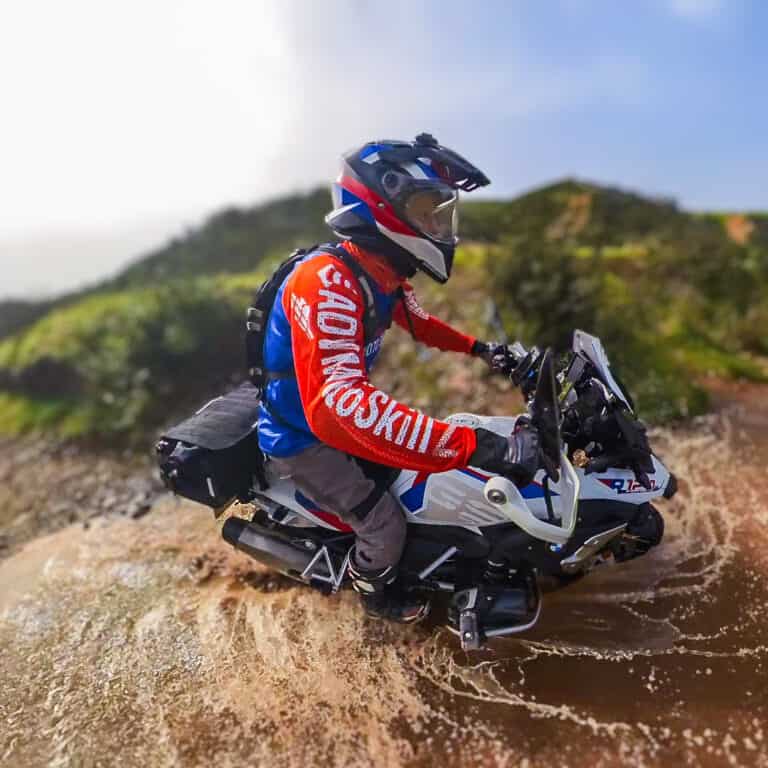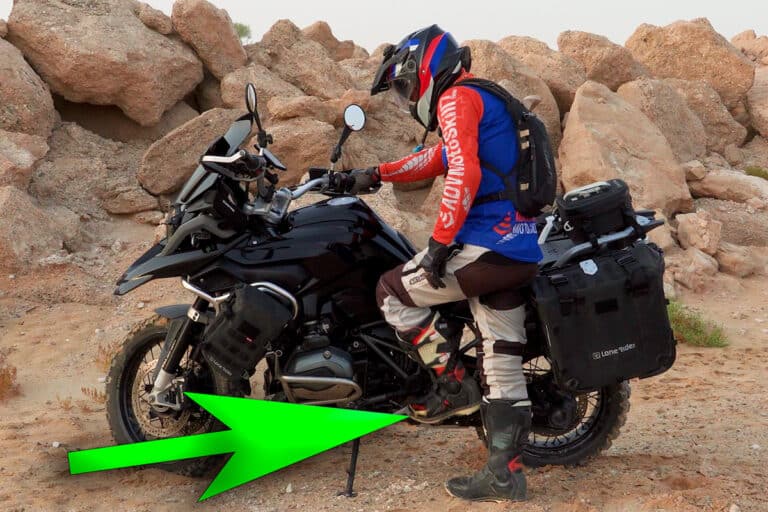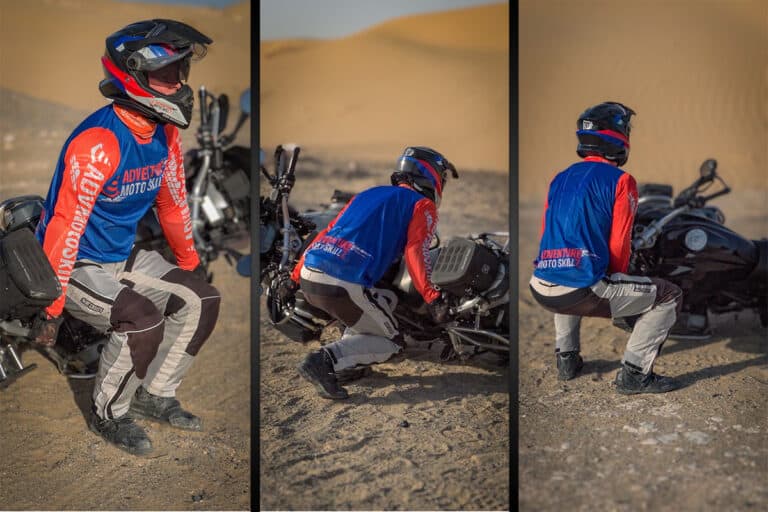How to do an Elephant Turn on an Off-Road Motorcycle (plus Donuts!)
Off-road motorcycle riders use a variety of techniques to navigate tricky terrain. One of the most talked about is the elephant turn. This maneuver can quickly get you out of trouble when you’re faced with an obstacle or other hazard in your path. In this blog post, we’ll show you how to complete your first elephant turn off-road on an ADV motorcycle, as well as share tips for competition-level mastery.
An elephant turn can be performed standing or seated on an adventure motorcycle by employing the steps of LEAN, LOCK, STEP, LOOK, and then GO. We advise learning these tight 180°-turns while standing first and then progressing to seated over time. Back-to-back elephant turns then become complete 360° donuts.
This post may contain Affiliate Links. Please see our Privacy & Disclosure Policy for more details.
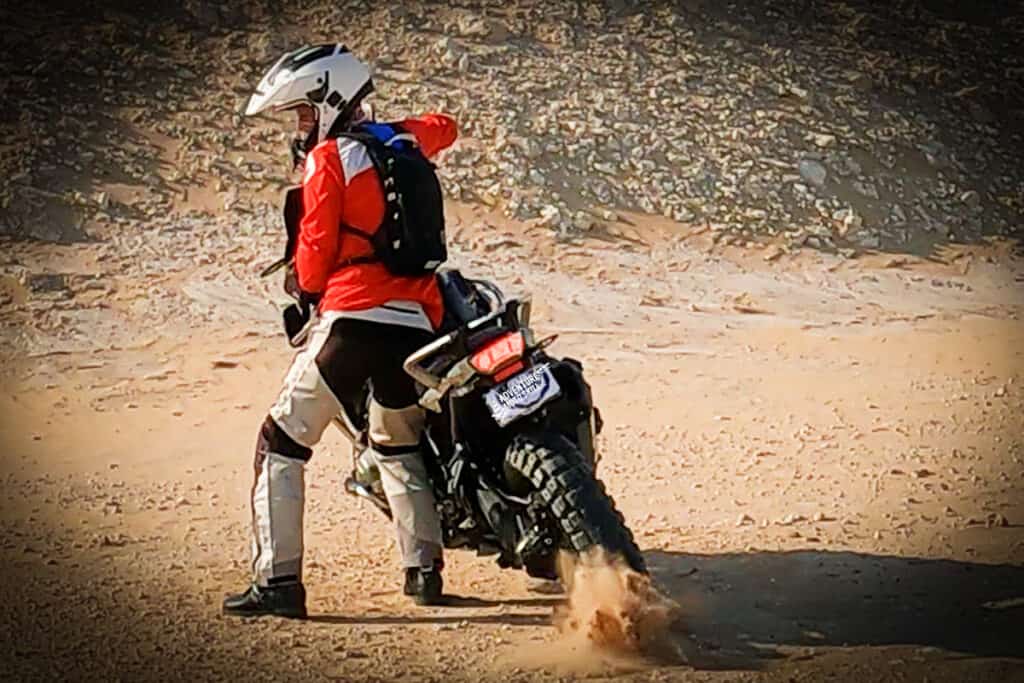
Whether you are simply looking to add another off-road riding skill to your resume or are keen to enter the next BMW GS Trophy competition, the elephant turn is well worth learning. They are fun to practice and are one of my go-to techniques to get out of tight spots on the trails.
Legend has it that the name “elephant turn” came about from riders encountering elephants blocking their trails. A situation such as this requires a quick and efficient turnaround technique. Feel free to use your local creatures to rename … “bear turn” … “tiger turn” … etc.
PRO TIP: Before starting elephant turn practice, be sure your bike ergonomics are properly set up for off-road riding and that you and your bike are kitted out with protective gear. Jump over to our Motorcycle Ergonomics post here for ideas.

Top-quality gear for your next adventure
Used and recommended by ADVMotoSkillZ
Beginner tips for ADV motorcycle 180° spin success
The standing elephant turn is the ideal starting point for learning this skill. When riding off-road, I prefer this version for many reasons. The standing elephant turn is easier to steady the bike on soft terrains like mud or deep sand, and it allows the bike weight to be supported by the pilot’s entire body rather than just one leg on the ground. Standing is also helpful when a 180° spin turn is needed to be done on an off-camber spot. Shorter riders and those with knee problems will also appreciate the efficiency of the standing posture 180° turn.
Let’s have a quick look at a standing elephant turn before we dissect its steps:
A large open outdoor space with a firmly packed terrain is ideal for learning the elephant turn. Hardpack dirt or gravel roads will provide a good supportive surface for the pilot to stand on and will also allow the rear tire to spin while learning how to break traction. Expect that you will drop the bike a few times and choose your training area wisely.
Set your traction control OFF to allow the rear wheel to spin. If traction control is on, then the bike’s computer will limit the rear spin potential. This safety feature is invaluable during road touring but will not allow a clean elephant turn. ABS settings will be bike specific according to model options and rider preference since ABS status is not a factor with this technique. On my 2016 BMW R1200GS LC, I turn ABS off when riding off-road or practicing elephant turns. If you have never felt your ABS, then try out the series of exercises here in our Emergency Braking post.
4 Steps for Standing Elephant Turn
LEAN
- Stand on the left side of the bike with your right hip touching the bike
- Bike engine is on, the side stand up, clutch is pulled in, the bike is in 1st gear (cover the front brake with 1 or 2 fingers)
- Now allow the bike to lean onto your right hip
- Do not hold up the bike with your arms, but instead support it with your body
The lean angle of the bike is what allows the tight 180° turn to be possible, much like leaning the bike into a corner during travel.
The more lean angle you can get, the easier the bike will turn
LOCK
- After leaning the bike onto your right hip, turn the handlebars into a full lock left position
- The front tire will be pointing as far left as it can go
Getting into full lock will point the bike in the direction it will soon be going. You do not need to struggle to try to keep the bike upright by pulling on the handlebars
Allow the weight of the bike to rest on your hip
STEP
- Take a step out to the side with your left foot (leftward away from the bike)
- Slightly rotate your foot into a toe-pointing-out position
By keeping your right foot planted firmly on the ground, the bike will remain safely supported. The step & toe out of the left foot will create an anchored pivot point for the bike to spin around as you ask it to turn 180°. The toe-out position is particularly important because it prevents you from having to take an additional step as the bike comes around.
If your step out & toe out isn’t far enough… you end up chasing the bike as it spins past you
LOOK
- Rotate your head fully to the left
- Look behind you in the direction you want the bike to go

Innovative Motorcycle Tool Sets – Compact & Reliable
Used and recommended by ADVMotoSkillZ
Look where you want to go applies to the elephant turn just as much as it applies to riding. As you turn your head, be sure to scan the area you are in and the direction you will be turning the bike to confirm a safe line of travel. Finish the scan by setting your sights on a location where you want the bike to stop at.
Keep that vision locked on the target as the bike spins around so that you will know when you need to pull in the clutch to stop the rotation
After completing LEAN, LOCK, STEP, & LOOK, the only thing left to do is to spin the bike around. To complete the elephant turn, release the clutch while simultaneously giving the bike a quick twist of the throttle. TIP: The amount of throttle is dependent on how much resistance the rear wheel needs to break traction. In some instances, it could be a 1/4 turn of the throttle.
Guide the bike to spin around you using your left foot as the pivot point. The more throttle you give, the faster the bike will spin around. Once the bike has turned 180°, fully engage both the clutch and front brake. You have done it!
Watch all of the steps in real time here:
Set realistic expectations as you begin to learn this technique. The perfect elephant turn may not happen on your first go, but with repeated practice, the steps will blend into one fluid motion.
The first time you encounter a blocked trail or hazard that can not be ridden over or around, you will be thrilled to jump off your bike and quickly turn around and ride on. The days of performing a 12-point turn with a 600lb/270kg bike are over!
If the bike feels out of control during an elephant turn attempt, then pull in the clutch fully to cut power to the engine. Let the bike roll and assist it upright with your right hip. Once the bike is standing tall, gently engage the front brake. (See the 2:06 mark of the video above)
Mastering clutch-throttle-brake balance is one of the many essential skills needed for the elephant turn. Let’s look:
See more close-up examples as well as elephant turns from the right side (weak side) in our Elephant Turn FAQ YouTube video here.
Mastering the seated Elephant Turn on an adventure motorcycle
A seated elephant turn follows the same LEAN, LOCK, STEP, LOOK recipe. However, all steps must happen much faster. In a left-sided seated elephant turn, the full weight of the bike lean is placed on the left leg.
A slowly executed 180° turn from the seated position will fatigue the left leg quickly and may lead to more frequent drops. These bikes are big and heavy, and when they reach a certain lean angle, they will want to drop.
SAFETY TIP: Do not try to fight a falling bike if it is at the angle of no return. Instead, pull the clutch all the way in to cut power to the engine and quickly take a WIDE step out with your left foot to allow the bike to fall to the ground beneath you. Keep yourself from getting trapped under the bike it at all costs. Once the bike is safely on its side, kill the engine, dismount, and take your time lifting it back up for your next try.
Seated elephant turns may also be a challenge on loose or sinking terrain due to the increased difficulty of creating a solid pivot point. If the ground beneath you is slippery or loose, be sure to use extra caution.
Likewise, riders who are very short compared to their bike height will need to use more speed and/or upper body strength to keep the bike from falling during the seated elephant turn. Keep practicing to find the body position that works best for you.
BMW GS Trophy competition Elephant Turn
Every second year, BMW hosts a GS Trophy competition for amateur riders. The seated elephant turn is a must-learn skill if you are keen to try for a spot in representing your country at the next event.
For competition, there is typically a 5-meter square box set up that participants are tasked to ride into and then perform a seated elephant turn. The added challenge is that you will need to place your left foot on a set spot throughout the 180° turn.
Check out an overview of common GS Trophy challenges on our YouTube channel here.
How to turn an elephant turn into a donut
The pinnacle of spin turns is the donut … complete 360° controlled spin of the bike. If you have ever done one, you already know how much fun they are. The donut is not about necessity, it is just about enjoying yourself on your bike.
If you aspire to do your first donut after mastering the seated elephant turn, start by simply performing two elephant turns in a row. Cutting the donut in half gives you a feel for the idea of spinning 360°, but with a short pause halfway through. After the double-elephant is feeling good, go ahead and try for the full-circle spin.
When first trying a whole donut, you may need to hop on your foot to keep up with the spinning bike. With practice, your technique will tighten up, and you will have more control.
At first, you may go 2/3 or 3/4 around, but with more experience, you will achieve your first donut. Congratulations!
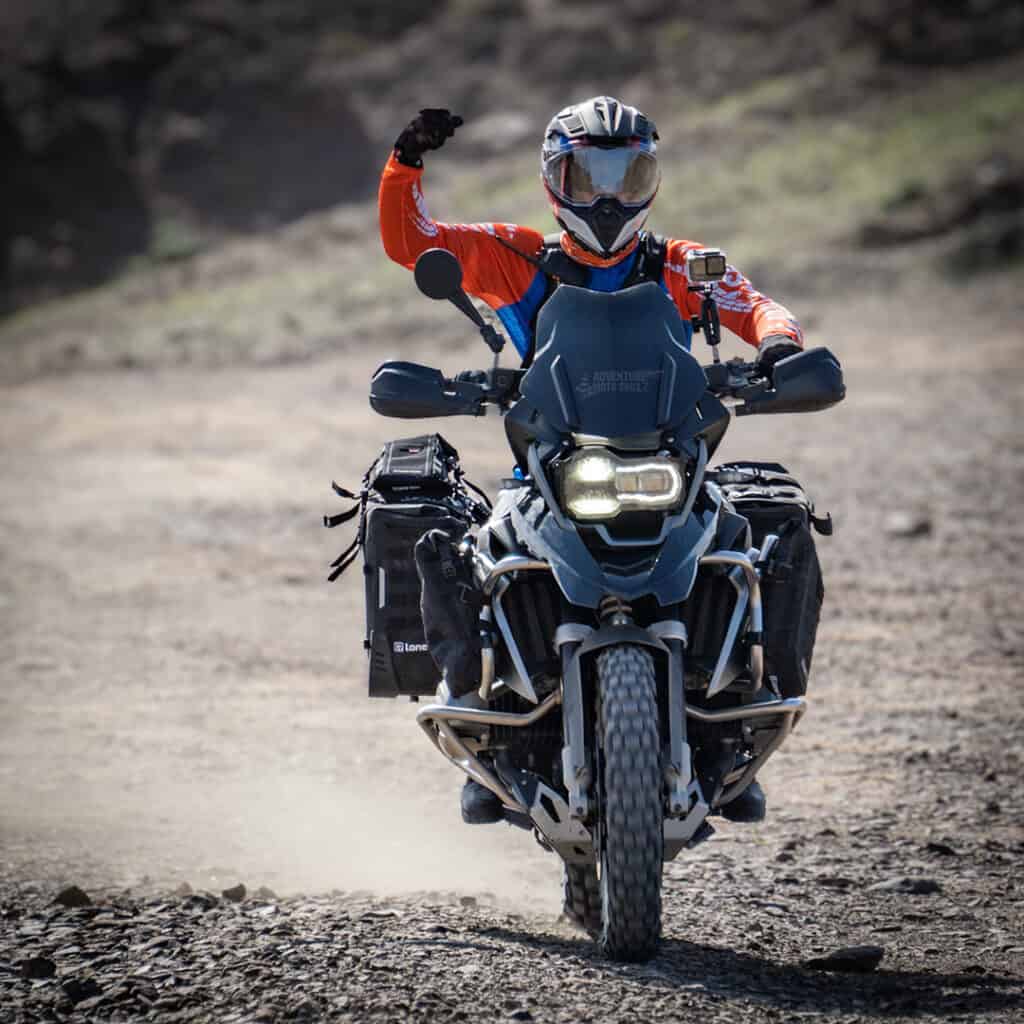
About the Author
Coach Mike is a Certified Off-Road Motorcycle Instructor & founder of ADVMotoSkillZ.
Riding tips from ADVMotoSkillZ reach thousands of international riders daily through social & blogs.
Click here to learn more about Mike’s motorcycle evolution from a Harley road rider to finding his true passion for off-road riding on a BMW 1200 GS.
If you would like to send Mike a quick message or invite him to provide training at your local facility, then visit the contact page here.

